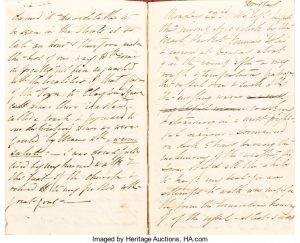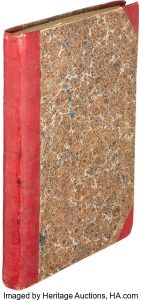This is the catalog entry for a handwritten diary of Elizabeth Romney, including some pages from her visit to Douglas. The auction is in early May, at Heritage Auctions in Dallas.

[George Romney]. Journal of Elizabeth Romney for the years 1834-1837. One volume, 4.75″ x 7.5″, 188 pages (76 blank), recorded at various places, April 14, 1834 through September 17, 1837. Romney’s diary, recorded when she was in her early twenties, began the year her father died and lasted off and on for three years.
Romney’s diary entries record everyday activities, such as practicing her drawing, books she read, and visits to friends and various locales in England. Her first diary entry of April 14, 1834 relates to her arrival in Liverpool, apparently her first time in the town. On April 15, she compared Liverpool to London, particularly its people. “The contrast however is much greater in the people you meet than in the streets themselves….I have not yet seen as gentlemanlike man & there appears to be a great lack of beauty in the ladies.” A month later, on May 15, writing from Whitestock Hall, she expressed her disappointment at the low prices her grandfather’s paintings realized at a sale. “We received this eveng. an accounting of the sale of the pictures, even I (tho’ my expectations were far from sanguine) [am?] grievously disappointed with the pitiable prices they had fetched. It wounds me to the heart to think that those glorious pieces, into which grandpapa had [thrown?] so much of his genius should be no more estimated than to be suffered to sell for little more than the value of their respective frames-how would his enthusiasm in the execution of those pieces have been damped could he have foreseen that in the course of a few years” his works would be held in such low esteem.
In late May 1837, Elizabeth Romney, her mother, and sister Jane traveled to the town of Douglas on the Isle of Man, arriving there in the evening of May 22. During her stay there, Elizabeth produced a drawing of the Tower of Refuge on St. Mary’s Isle, which she included in her diary. On the 24th Elizabeth and her mother “went into the town to shop & walked to the bridge. The shops appear very good but I have not as yet been into many. Douglas certainly is a beautiful place….I was particularly pleased on entering the harbor with the [?] House the site overlooking the Bay is so extremely commanding & it is so little indebted to any adventitious adornment – a green slope studded here & there with wild [?] in full bloom forms the simple lawn & is much more in accordance with my taste. The character of the scenery – the mamby pamby style of ornament – wch. is now generally adopted under the title landscape gardening. The Tower of Refuge wch. stands on the little island known by the name of St. Mary’s Rock & planned by Sir Wm. Hillary bespeaks him a man of public spirit & great taste.”
From the Estate of Malcolm S. Forbes.

Condition: The cover of the diary, quarter red leather, is in fine condition as is the internal text block.
More Information:
Elizabeth Romney (1814-1893) was the daughter of John Romney (1758-1834) and Jane Kannal Romney of Whitestock Hall, England, and the granddaughter of the English painter George Romney. She took ownership of her grandfather’s paintings, drawings, and manuscripts after the death of her father. She never married and was the last Romney to live at Whitestock Hall, which was finally sold in 1901. George Romney purchased land in Whitestock, England, two years before his death, upon which his son John built Whitestock Hall, which stayed in the family until Elizabeth moved from the house later in her life.
George Romney (1734-1802) was English portrait painter. Born in the northwest of England, Romney traveled to London in 1762 and quickly became a fashionable portrait painter. His most famous portrait is The Death of General Wolfe. In later life he turned his hand to literary subjects, with Milton and His Daughters and Scene from The Tempest among his works. Today, he is considered one of the finest painters of the English School of Art.

